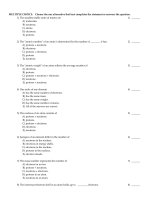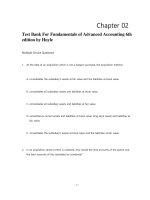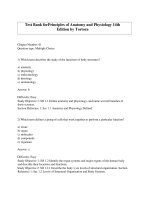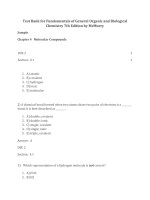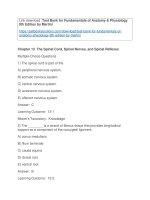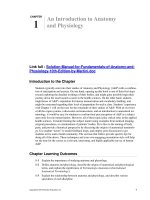Test bank for fundamentals of anatomy and physiology 11e c01
Bạn đang xem bản rút gọn của tài liệu. Xem và tải ngay bản đầy đủ của tài liệu tại đây (170.85 KB, 21 trang )
Chapterȱ1
AnȱIntroductionȱtoȱAnatomyȱandȱPhysiology
Multiple Choice Questions
1) Anatomyȱisȱtoȱ________ȱasȱphysiologyȱisȱtoȱ________.
A) function;ȱform
B) form;ȱstructure
C) structure;ȱfunction
D) structure;ȱform
E) growth;ȱform
Answer: C
LearningȱOutcome: 1-2
BloomȇsȱTaxonomy: Understanding
2) Theȱanalysisȱofȱtheȱinternalȱstructureȱofȱindividualȱcellsȱisȱcalled
A) cytology.
B) histology.
C) embryology.
D) physiology.
E) anatomy.
Answer: A
LearningȱOutcome: 1-2
BloomȇsȱTaxonomy: Remembering
3) Theȱstudyȱofȱtheȱgeneralȱformȱandȱsuperficialȱmarkingsȱofȱanȱorganismȱisȱcalledȱ________
anatomy.
A) gross
B) surface
C) systemic
D) regional
E) surgical
Answer: B
LearningȱOutcome: 1-2
BloomȇsȱTaxonomy: Remembering
4) Anatomicalȱfeaturesȱthatȱchangeȱduringȱillnessȱareȱstudiedȱinȱ________ȱanatomy.
A) gross
B) surface
C) microscopic
D) pathological
E) regional
Answer: D
LearningȱOutcome: 1-2
BloomȇsȱTaxonomy: Remembering
Copyrightȱ©ȱ2018ȱPearsonȱEducation,ȱInc.
2ȱȱȱTestȱBankȱforȱFundamentalsȱofȱAnatomyȱ&ȱPhysiology,ȱ11e
5) Theȱstudyȱofȱtheȱfirstȱtwoȱmonthsȱofȱdevelopmentȱisȱtermed
A) histology.
B) embryology.
C) cytology.
D) pathology.
E) organology.
Answer: B
LearningȱOutcome: 1-2
BloomȇsȱTaxonomy: Remembering
6) Theȱstudyȱofȱtheȱfunctionȱofȱspecificȱorganȱsystemsȱisȱcalled
A) systemicȱphysiology.
B) organȱphysiology.
C) cellȱphysiology.
D) pathologicalȱphysiology.
E) histology.
Answer: A
LearningȱOutcome: 1-2
BloomȇsȱTaxonomy: Remembering
7) Cardiovascularȱfunctionȱisȱanȱexampleȱof
A) histophysiology.
B) organȱphysiology.
C) systemicȱphysiology.
D) pathologicalȱphysiology.
E) physiologicalȱchemistry.
Answer: C
LearningȱOutcome: 1-2
BloomȇsȱTaxonomy: Remembering
8) Theȱstudyȱofȱtheȱliverȱisȱtoȱgrossȱanatomyȱasȱtheȱstudyȱofȱaȱliverȱcellȱisȱto
A) physiology.
B) regionalȱanatomy.
C) cytology.
D) systemicȱanatomy.
E) radiographicȱanatomy.
Answer: C
LearningȱOutcome: 1-2
BloomȇsȱTaxonomy: Remembering
9) Identifyȱtheȱbranchȱofȱbiologicalȱscienceȱthatȱstudiesȱtheȱexternalȱandȱinternalȱstructureȱofȱthe
bodyȱandȱtheȱphysicalȱrelationshipȱamongȱbodyȱparts.
A) genetics
B) physiology
C) embryology
D) anatomy
E) cytology
Answer: D
LearningȱOutcome: 1-2
BloomȇsȱTaxonomy: Remembering
Copyrightȱ©ȱ2018ȱPearsonȱEducation,ȱInc.
Chapterȱ1ȱȱAn Introduction to Anatomy and Physiologyȱȱȱ3
10) Identifyȱtheȱbranchȱofȱbiologicalȱscienceȱthatȱdealsȱwithȱtheȱstudyȱofȱhowȱlivingȱorganisms
performȱtheirȱvitalȱfunctions.
A) genetics
B) physiology
C) embryology
D) anatomy
E) cytology
Answer: B
LearningȱOutcome: 1-2
BloomȇsȱTaxonomy: Remembering
11) Theȱstudyȱofȱtheȱchangesȱinȱformȱthatȱoccurȱbetweenȱconceptionȱandȱphysicalȱmaturityȱis
calledȱ________ȱanatomy.
A) developmental
B) clinical
C) systemic
D) embryological
E) physiological
Answer: A
LearningȱOutcome: 1-3
BloomȇsȱTaxonomy: Remembering
12) Theȱstudyȱofȱtheȱanatomicalȱorganizationȱofȱspecificȱareasȱofȱtheȱbodyȱisȱcalledȱ________
anatomy.
A) gross
B) surface
C) systemic
D) regional
E) clinical
Answer: D
LearningȱOutcome: 1-2
BloomȇsȱTaxonomy: Remembering
13) Theȱstudyȱofȱtheȱrelationshipsȱofȱtheȱbodyȇsȱstructuresȱbyȱexaminingȱcrossȱsectionsȱofȱtissuesȱor
organsȱisȱcalledȱ________ȱanatomy.
A) gross
B) surface
C) systemic
D) regional
E) sectional
Answer: E
LearningȱOutcome: 1-2
BloomȇsȱTaxonomy: Remembering
Copyrightȱ©ȱ2018ȱPearsonȱEducation,ȱInc.
4ȱȱȱTestȱBankȱforȱFundamentalsȱofȱAnatomyȱ&ȱPhysiology,ȱ11e
14) Whichȱofȱtheȱfollowingȱisȱarrangedȱinȱcorrectȱorderȱfromȱtheȱmostȱcomplexȱtoȱtheȱsimplest?
A) cellular,ȱtissue,ȱmolecular,ȱsystem,ȱorgan,ȱorganism
B) molecular,ȱcellular,ȱtissue,ȱorgan,ȱsystem,ȱorganism
C) tissue,ȱcellular,ȱmolecular,ȱorgan,ȱsystem,ȱorganism
D) organ,ȱorganism,ȱmolecular,ȱcellular,ȱtissue,ȱsystem
E) organism,ȱsystem,ȱorgan,ȱtissue,ȱcellular,ȱmolecular
Answer: E
LearningȱOutcome: 1-3
BloomȇsȱTaxonomy: Analyzing
15) Whichȱorganȱsystemȱprovidesȱsupport,ȱprotectionȱofȱsoftȱtissue,ȱmineralȱstorage,ȱandȱblood
formation?
A) integumentary
B) muscular
C) skeletal
D) nervous
E) endocrine
Answer: C
LearningȱOutcome: 1-3
BloomȇsȱTaxonomy: Remembering
16) Whichȱorganȱsystemȱtransportsȱnutrients,ȱmetabolicȱwastes,ȱgases,ȱandȱdefenseȱcells?
A) cardiovascular
B) digestive
C) muscular
D) respiratory
E) urinary
Answer: A
LearningȱOutcome: 1-3
BloomȇsȱTaxonomy: Remembering
17) Whichȱorganȱsystemȱincludesȱtheȱspleenȱandȱtheȱtonsils?
A) digestive
B) endocrine
C) nervous
D) cardiovascular
E) lymphatic
Answer: E
LearningȱOutcome: 1-3
BloomȇsȱTaxonomy: Remembering
18) Theȱkidneysȱandȱuretersȱareȱorgansȱofȱtheȱ________ȱsystem.
A) endocrine
B) digestive
C) respiratory
D) urinary
E) lymphatic
Answer: D
LearningȱOutcome: 1-3
BloomȇsȱTaxonomy: Remembering
Copyrightȱ©ȱ2018ȱPearsonȱEducation,ȱInc.
Chapterȱ1ȱȱAn Introduction to Anatomy and Physiologyȱȱȱ5
19) Theȱpituitaryȱglandȱandȱthyroidȱglandȱareȱorgansȱofȱtheȱ________ȱsystem.
A) endocrine
B) cardiovascular
C) respiratory
D) lymphatic
E) digestive
Answer: A
LearningȱOutcome: 1-3
BloomȇsȱTaxonomy: Remembering
20) Whichȱorganȱsystemȱremovesȱcarbonȱdioxideȱfromȱtheȱbloodstream?
A) cardiovascular
B) lymphatic
C) respiratory
D) digestive
E) endocrine
Answer: C
LearningȱOutcome: 1-3
BloomȇsȱTaxonomy: Remembering
21) Lungsȱareȱtoȱtheȱrespiratoryȱsystemȱasȱtheȱliverȱisȱtoȱtheȱ________ȱsystem.
A) lymphatic
B) urinary
C) digestive
D) cardiovascular
E) nervous
Answer: C
LearningȱOutcome: 1-3
BloomȇsȱTaxonomy: Understanding
22) Skin,ȱhair,ȱandȱnailsȱareȱassociatedȱwithȱtheȱ________ȱsystem.
A) skeletal
B) muscular
C) integumentary
D) endocrine
E) immune
Answer: C
LearningȱOutcome: 1-3
BloomȇsȱTaxonomy: Remembering
Copyrightȱ©ȱ2018ȱPearsonȱEducation,ȱInc.
6ȱȱȱTestȱBankȱforȱFundamentalsȱofȱAnatomyȱ&ȱPhysiology,ȱ11e
23) Aȱchemicalȱimbalanceȱinȱtheȱbodyȱcanȱcauseȱtheȱheartȱtoȱstopȱpumpingȱblood,ȱwhichȱinȱturn
willȱcauseȱotherȱtissuesȱandȱorgansȱtoȱceaseȱfunctioning.ȱThisȱobservationȱsupportsȱtheȱview
that
A) allȱorganismsȱareȱcomposedȱofȱcells.
B) allȱlevelsȱofȱorganizationȱwithinȱanȱorganismȱareȱinterdependent.
C) chemicalȱmoleculesȱmakeȱupȱcells.
D) bloodȱhasȱmagicalȱproperties.
E) congenitalȱdefectsȱcanȱbeȱlife-threatening.
Answer: B
LearningȱOutcome: 1-3
BloomȇsȱTaxonomy: Applying
24) Inȱgeneral,ȱtheȱnervousȱsystemȱdoesȱeachȱofȱtheȱfollowingȱexcept
A) helpȱtoȱmaintainȱhomeostasis.
B) respondȱrapidlyȱtoȱchange.
C) directȱlong-termȱresponsesȱtoȱchange.
D) directȱveryȱspecificȱresponses.
E) interpretȱsensoryȱinformation.
Answer: C
LearningȱOutcome: 1-3
BloomȇsȱTaxonomy: Understanding
25) Whichȱoneȱofȱtheȱfollowingȱisȱnot aȱcharacteristicȱofȱtheȱendocrineȱsystem?
A) releasesȱchemicalȱmessengersȱcalledȱhormones
B) producesȱaȱmoreȱrapidȱresponseȱthanȱtheȱnervousȱsystem
C) producesȱeffectsȱthatȱlastȱforȱdaysȱorȱlonger
D) producesȱanȱeffectȱthatȱinvolvesȱseveralȱorgansȱorȱtissuesȱatȱtheȱsameȱtime
E) importantȱhomeostaticȱsystem
Answer: B
LearningȱOutcome: 1-3
BloomȇsȱTaxonomy: Understanding
26) Systemicȱphysiologyȱis
A) theȱstudyȱofȱtheȱeffectsȱofȱdiseasesȱonȱsystemȱfunctions.
B) theȱstudyȱofȱtheȱfunctionȱofȱspecificȱorgans.
C) theȱstudyȱofȱtheȱfunctionalȱchemistryȱofȱcells.
D) theȱstudyȱofȱallȱaspectsȱofȱtheȱfunctioningȱofȱspecificȱorgansȱsystems.
E) theȱstudyȱofȱfunctionsȱofȱtheȱwholeȱhumanȱbody.
Answer: D
LearningȱOutcome: 1-3
BloomȇsȱTaxonomy: Remembering
Copyrightȱ©ȱ2018ȱPearsonȱEducation,ȱInc.
Chapterȱ1ȱȱAn Introduction to Anatomy and Physiologyȱȱȱ7
27) Anatomyȱusesȱaȱspecialȱlanguage,ȱcalledȱ________ȱterminology,ȱwhichȱinvolvesȱtheȱuseȱof
wordȱroots,ȱprefixes,ȱsuffixes,ȱandȱcombiningȱformsȱtoȱconstructȱtermsȱrelatedȱtoȱtheȱbodyȱin
healthȱandȱdisease.
A) clinical
B) pathological
C) medical
D) anatomical
E) surgical
Answer: C
LearningȱOutcome: 1-4
BloomȇsȱTaxonomy: Remembering
28) ________ȱservesȱasȱaȱworldwideȱofficialȱstandardȱofȱanatomicalȱvocabulary.
A) GrayȇsȱAnatomy
B) TerminologiaȱAnatomica
C) HippocraticȱCorpus
D) AnatomiaȱInteligencia
E) DeȱMateriaȱMedica
Answer: B
LearningȱOutcome: 1-4
BloomȇsȱTaxonomy: Remembering
29) Manyȱmedicalȱtermsȱareȱrootedȱin
A) Latin.
B) German.
C) Greek.
D) Phoenician.
E) GreekȱorȱLatin.
Answer: E
LearningȱOutcome: 1-4
BloomȇsȱTaxonomy: Remembering
30) Theȱquadrantsȱofȱtheȱabdominopelvicȱregionȱincludeȱallȱofȱtheȱfollowingȱexcept
A) rightȱupperȱquadrantȱ(RUQ).
B) rightȱlowerȱquadrantȱ(RLQ).
C) leftȱupperȱquadrantȱ(LUQ).
D) leftȱlowerȱquadrantȱ(LLQ).
E) pelvicȱquadrant.
Answer: E
LearningȱOutcome: 1-5
BloomȇsȱTaxonomy: Remembering
Copyrightȱ©ȱ2018ȱPearsonȱEducation,ȱInc.
8ȱȱȱTestȱBankȱforȱFundamentalsȱofȱAnatomyȱ&ȱPhysiology,ȱ11e
31) Whichȱofȱtheȱfollowingȱisȱnotȱconsideredȱanȱabdominopelvicȱregion?
A) rightȱhypochondriac
B) rightȱinguinalȱregion
C) leftȱlumbar
D) leftȱhypochondriac
E) upper
Answer: E
LearningȱOutcome: 1-5
BloomȇsȱTaxonomy: Understanding
32) Aȱpersonȱwhoȱisȱstandingȱfacingȱforwardȱwithȱhandsȱatȱtheȱsidesȱandȱpalmsȱfacingȱforwardȱis
inȱtheȱ________ȱposition.
A) supine
B) prone
C) anatomical
D) frontal
E) sagittal
Answer: C
LearningȱOutcome: 1-5
BloomȇsȱTaxonomy: Remembering
33) Anȱanatomicalȱtermȱthatȱmeansȱtheȱsame asȱventralȱis
A) posterior.
B) inferior.
C) abdominal.
D) anterior.
E) superior.
Answer: D
LearningȱOutcome: 1-5
BloomȇsȱTaxonomy: Remembering
34) Theȱheartȱisȱ________ȱtoȱtheȱlungs.
A) lateral
B) medial
C) posterior
D) proximal
E) distal
Answer: B
LearningȱOutcome: 1-5
BloomȇsȱTaxonomy: Applying
35) Theȱwristȱisȱ________ȱtoȱtheȱelbow.
A) proximal
B) distal
C) lateral
D) medial
E) horizontal
Answer: B
LearningȱOutcome: 1-5
BloomȇsȱTaxonomy: Applying
Copyrightȱ©ȱ2018ȱPearsonȱEducation,ȱInc.
Chapterȱ1ȱȱAn Introduction to Anatomy and Physiologyȱȱȱ9
36) Theȱchinȱisȱ________ȱtoȱtheȱnose.
A) anterior
B) superior
C) posterior
D) inferior
E) medial
Answer: D
LearningȱOutcome: 1-5
BloomȇsȱTaxonomy: Applying
37) Whichȱofȱtheȱfollowingȱregionsȱcorrespondsȱtoȱtheȱbuttocks?
A) pelvic
B) cephalic
C) gluteal
D) lumbar
E) thoracic
Answer: C
LearningȱOutcome: 1-5
BloomȇsȱTaxonomy: Remembering
38) Whichȱofȱtheȱfollowingȱtermsȱrefersȱtoȱtheȱfoot?
A) cervical
B) brachial
C) antebrachial
D) femoral
E) pedal
Answer: E
LearningȱOutcome: 1-5
BloomȇsȱTaxonomy: Remembering
39) Whichȱplaneȱdividesȱtheȱbodyȱintoȱrightȱandȱleftȱparts?
A) proximal
B) frontal
C) orthogonal
D) transverse
E) sagittal
Answer: E
LearningȱOutcome: 1-5
BloomȇsȱTaxonomy: Remembering
40) Aȱmidsagittalȱsectionȱofȱtheȱbodyȱwouldȱpassȱthroughȱthe
A) kidney.
B) lung.
C) heart.
D) spleen.
E) leg.
Answer: C
LearningȱOutcome: 1-5
BloomȇsȱTaxonomy: Remembering
Copyrightȱ©ȱ2018ȱPearsonȱEducation,ȱInc.
10ȱȱȱTestȱBankȱforȱFundamentalsȱofȱAnatomyȱ&ȱPhysiology,ȱ11e
41) Theȱplaneȱthatȱseparatesȱtheȱabdominalȱandȱtheȱpelvicȱcavitiesȱis
A) theȱmediastinum.
B) sagittalȱonȱtheȱbrachium.
C) transverseȱatȱtheȱhips.
D) midsagittalȱonȱtheȱtrunk.
E) superiorȱtoȱtheȱthorax.
Answer: C
LearningȱOutcome: 1-5
BloomȇsȱTaxonomy: Remembering
42) Termsȱofȱanatomicalȱdirectionȱareȱusedȱtoȱdescribe
A) oneȱbodyȱpartȱinȱrelationȱtoȱanother.
B) surgicalȱprocedures.
C) aȱsupineȱposition.
D) theȱnervousȱsystem.
E) livingȱmatter.
Answer: A
LearningȱOutcome: 1-5
BloomȇsȱTaxonomy: Applying
43) Whileȱstandingȱerect,ȱtheȱdirectionȱofȱcaudalȱis
A) towardȱtheȱhead.
B) towardȱtheȱheel.
C) lateralȱtoȱtheȱtrunk.
D) medialȱtoȱtheȱsides.
E) posteriorȱtoȱtheȱhead.
Answer: B
LearningȱOutcome: 1-5
BloomȇsȱTaxonomy: Applying
44) Whileȱstandingȱinȱtheȱanatomicalȱposition,
A) frontȱrefersȱtoȱanterior.
B) frontȱrefersȱtoȱventral.
C) backȱrefersȱtoȱposterior.
D) backȱrefersȱtoȱdorsal.
E) Allȱofȱtheȱanswersȱareȱcorrect.
Answer: E
LearningȱOutcome: 1-5
BloomȇsȱTaxonomy: Applying
45) Theȱliverȱisȱprimarilyȱlocatedȱinȱtheȱ________ȱquadrant.
A) rightȱupper
B) leftȱupper
C) rightȱlower
D) leftȱlower
E) hepatic
Answer: A
LearningȱOutcome: 1-5
BloomȇsȱTaxonomy: Understanding
Copyrightȱ©ȱ2018ȱPearsonȱEducation,ȱInc.
Chapterȱ1ȱȱAn Introduction to Anatomy and Physiologyȱȱȱ11
46) Theȱurinaryȱbladderȱisȱfoundȱinȱtheȱ________ȱquadrantȱandȱtheȱ________ȱquadrant.
A) rightȱupper;ȱrightȱlower
B) leftȱupper;ȱleftȱlower
C) leftȱupper;ȱrightȱupper
D) rightȱlower;ȱleftȱlower
Answer: D
LearningȱOutcome: 1-5
BloomȇsȱTaxonomy: Understanding
47) Aȱpersonȱlyingȱfaceȱdownȱisȱinȱtheȱ________ȱposition.
A) anatomical
B) prone
C) supine
D) ventral
E) prostrate
Answer: B
LearningȱOutcome: 1-5
BloomȇsȱTaxonomy: Remembering
48) Aȱpersonȱlyingȱonȱtheȱbedȱandȱgazingȱatȱtheȱceilingȱisȱinȱtheȱ________ȱposition.
A) prone
B) supine
C) anatomical
D) dorsal
E) caudal
Answer: B
LearningȱOutcome: 1-5
BloomȇsȱTaxonomy: Remembering
49) Theȱcommonȱtermȱforȱtheȱbuccalȱregionȱisȱthe
A) back.
B) waist.
C) breast.
D) cheeks.
E) buttocks.
Answer: D
LearningȱOutcome: 1-5
BloomȇsȱTaxonomy: Remembering
50) Theȱcommonȱtermȱforȱtheȱcarpalȱregionȱisȱthe
A) wrist.
B) fingers.
C) ankle.
D) shin.
E) chest.
Answer: A
LearningȱOutcome: 1-5
BloomȇsȱTaxonomy: Remembering
Copyrightȱ©ȱ2018ȱPearsonȱEducation,ȱInc.
12ȱȱȱTestȱBankȱforȱFundamentalsȱofȱAnatomyȱ&ȱPhysiology,ȱ11e
51) Theȱcommonȱnameȱforȱtheȱpollexȱisȱthe
A) earȱlobe.
B) belly.
C) bigȱtoe.
D) hand.
E) thumb.
Answer: E
LearningȱOutcome: 1-5
BloomȇsȱTaxonomy: Remembering
52) Theȱcommonȱnameȱforȱtheȱpatellaȱisȱthe
A) forehead.
B) knee.
C) heel.
D) palmȱofȱtheȱhand.
E) chin.
Answer: B
LearningȱOutcome: 1-5
BloomȇsȱTaxonomy: Remembering
53) Aȱcutȱparallelȱtoȱtheȱmidsagittalȱplaneȱwouldȱproduceȱa(n)ȱ________ȱsection.
A) frontal
B) transverse
C) oblique
D) parasagittal
E) coronal
Answer: D
LearningȱOutcome: 1-5
BloomȇsȱTaxonomy: Remembering
54) Theȱabdominopelvicȱregionȱthatȱisȱimmediatelyȱsuperiorȱtoȱtheȱumbilicalȱregionȱisȱthe
A) hypogastricȱregion.
B) leftȱhypochondriacȱregion.
C) rightȱinguinalȱregion.
D) epigastricȱregion.
E) leftȱlumbarȱregion.
Answer: D
LearningȱOutcome: 1-5
BloomȇsȱTaxonomy: Remembering
55) Theȱabdominopelvicȱregionȱthatȱisȱimmediatelyȱsuperiorȱtoȱtheȱhypogastricȱregionȱisȱthe
A) umbilicalȱregion.
B) leftȱhypochondriacȱregion.
C) rightȱinguinalȱregion.
D) epigastricȱregion.
E) leftȱlumbarȱregion.
Answer: A
LearningȱOutcome: 1-5
BloomȇsȱTaxonomy: Remembering
Copyrightȱ©ȱ2018ȱPearsonȱEducation,ȱInc.
Chapterȱ1ȱȱAn Introduction to Anatomy and Physiologyȱȱȱ13
56) Theȱdiaphragmȱmuscleȱseparatesȱtheȱ________ȱfromȱtheȱ________.
A) pleuralȱcavity;ȱmediastinum
B) thoracicȱcavity;ȱabdominopelvicȱcavity
C) pericardialȱcavity;ȱpleuralȱcavity
D) abdominalȱcavity;ȱpelvicȱcavity
E) pericardialȱsac;ȱpericardialȱcavity
Answer: B
LearningȱOutcome: 1-6
BloomȇsȱTaxonomy: Remembering
57) Theȱthoracicȱcavityȱcontainsȱthe
A) coelom.
B) pericardialȱcavity.
C) pelvicȱcavity.
D) pleuralȱcavities.
E) pericardialȱandȱpleuralȱcavities.
Answer: E
LearningȱOutcome: 1-6
BloomȇsȱTaxonomy: Remembering
58) Theȱserousȱmembraneȱcoveringȱtheȱstomachȱandȱmostȱofȱtheȱintestinesȱisȱcalledȱthe
A) pericardium.
B) peritoneum.
C) pleura.
D) mediastinum.
E) abdomen.
Answer: B
LearningȱOutcome: 1-6
BloomȇsȱTaxonomy: Remembering
59) Whichȱofȱtheȱfollowingȱorgansȱisȱdescribedȱasȱretroperitoneal?
A) stomach
B) kidney
C) urinaryȱbladder
D) largeȱintestine
E) spleen
Answer: B
LearningȱOutcome: 1-6
BloomȇsȱTaxonomy: Remembering
60) Theȱrightȱpleuralȱcavityȱcontains
A) theȱheart.
B) theȱtrachea.
C) theȱleftȱlung.
D) theȱrightȱlung.
E) bothȱlungs.
Answer: D
LearningȱOutcome: 1-6
BloomȇsȱTaxonomy: Remembering
Copyrightȱ©ȱ2018ȱPearsonȱEducation,ȱInc.
14ȱȱȱTestȱBankȱforȱFundamentalsȱofȱAnatomyȱ&ȱPhysiology,ȱ11e
61) Visceralȱpericardiumȱisȱlocated
A) onȱtheȱheartȱitself.
B) liningȱtheȱpleuralȱcavity.
C) liningȱtheȱpericardialȱcavity.
D) onȱtheȱlungȱitself.
E) liningȱtheȱperitonealȱcavity.
Answer: A
LearningȱOutcome: 1-6
BloomȇsȱTaxonomy: Remembering
62) Theȱmediastinum
A) containsȱtheȱpleuralȱcavities.
B) separatesȱtheȱpleuralȱcavities.
C) containsȱtheȱpericardialȱcavity.
D) containsȱtheȱpleuralȱcavitiesȱandȱpericardialȱcavity.
E) separatesȱtheȱpleuralȱcavitiesȱandȱincludesȱtheȱpericardialȱcavity.
Answer: E
LearningȱOutcome: 1-6
BloomȇsȱTaxonomy: Remembering
63) Identifyȱtheȱstructureȱlocatedȱwithinȱtheȱmediastinum.
A) pericardialȱcavity
B) smallȱintestine
C) lung
D) spleen
E) stomach
Answer: A
LearningȱOutcome: 1-6
BloomȇsȱTaxonomy: Remembering
64) Whichȱofȱtheȱfollowingȱimagingȱtechniquesȱisȱusedȱtoȱmonitorȱbloodȱflowȱthroughȱspecific
organs,ȱsuchȱasȱtheȱbrain,ȱheart,ȱlungs,ȱandȱkidneys?
A) PETȱscan
B) ultrasound
C) digitalȱsubtractionȱangiography
D) MRI
E) CTȱscan
Answer: C
LearningȱOutcome: 1-6
BloomȇsȱTaxonomy: Applying
65) Theȱ________ȱisȱtheȱmembraneȱthatȱcoversȱtheȱinternalȱorgans.
A) parietalȱserosa
B) visceralȱserosa
C) mucousȱmembrane
D) cutaneousȱmembrane
E) serousȱmembrane
Answer: B
LearningȱOutcome: 1-6
BloomȇsȱTaxonomy: Remembering
Copyrightȱ©ȱ2018ȱPearsonȱEducation,ȱInc.
Chapterȱ1ȱȱAn Introduction to Anatomy and Physiologyȱȱȱ15
66) Theȱ________ȱisȱtheȱmembraneȱthatȱcoversȱtheȱinnerȱsurfaceȱofȱcavityȱwalls.
A) parietalȱserosa
B) visceralȱserosa
C) mucousȱmembrane
D) cutaneousȱmembrane
E) serousȱmembrane
Answer: A
LearningȱOutcome: 1-6
BloomȇsȱTaxonomy: Remembering
67) Whichȱofȱtheȱfollowingȱimagingȱtechniquesȱcausesȱparticlesȱwithinȱatomsȱtoȱlineȱupȱinȱuniform
directionȱallowingȱtheȱimagingȱofȱsoftȱtissue?
A) PETȱscan
B) ultrasound
C) digitalȱsubtractionȱangiography
D) MRI
E) CTȱscan
Answer: D
LearningȱOutcome: 1-6
BloomȇsȱTaxonomy: Applying
68) Theȱimagingȱtechniqueȱthatȱassessesȱmetabolicȱandȱphysiologicalȱactivityȱofȱaȱstructureȱis
calledȱa
A) PETȱscan.
B) ultrasound.
C) digitalȱsubtractionȱangiography.
D) MRI.
E) CTȱscan.
Answer: A
LearningȱOutcome: 1-6
BloomȇsȱTaxonomy: Applying
69) Theȱimagingȱtechniqueȱthatȱbuildsȱanȱimageȱbyȱusingȱsoundȱwavesȱreflectedȱbyȱinternal
structuresȱisȱcalledȱa
A) PETȱscan.
B) ultrasound.
C) digitalȱsubtractionȱangiography.
D) MRI.
E) CTȱscan.
Answer: B
LearningȱOutcome: 1-6
BloomȇsȱTaxonomy: Applying
Copyrightȱ©ȱ2018ȱPearsonȱEducation,ȱInc.
16ȱȱȱTestȱBankȱforȱFundamentalsȱofȱAnatomyȱ&ȱPhysiology,ȱ11e
70) Theȱcentralȱprincipleȱofȱphysiologyȱis
A) nutrition.
B) reflexes.
C) homeostasis.
D) stimulation.
E) temperatureȱregulation.
Answer: C
LearningȱOutcome: 1-7
BloomȇsȱTaxonomy: Remembering
71) Theȱmaintenanceȱofȱaȱrelativelyȱconstantȱinternalȱenvironmentȱinȱanȱorganismȱisȱtermed
A) positiveȱfeedback.
B) homeostasis.
C) negativeȱfeedback.
D) effectorȱcontrol.
E) integration.
Answer: B
LearningȱOutcome: 1-7
BloomȇsȱTaxonomy: Remembering
72) Theȱtendencyȱforȱphysiologicalȱsystemsȱtoȱstabilizeȱinternalȱconditionsȱisȱcalled
A) self-regulation.
B) homeostasis.
C) equilibriosis.
D) hemopoiesis.
E) amplification.
Answer: B
LearningȱOutcome: 1-7
BloomȇsȱTaxonomy: Remembering
73) Homeostaticȱregulationȱusuallyȱinvolvesȱa(n)ȱ________ȱthatȱdetectsȱaȱparticularȱstimulus,ȱand
a(n)ȱ________ȱthatȱrespondsȱtoȱtheȱstimulusȱbyȱcommunicatingȱwithȱa(n)ȱ________ȱwhose
activityȱhasȱanȱeffectȱonȱtheȱsameȱstimulus.
A) controlȱcenter;ȱeffector;ȱreceptor
B) receiver;ȱcommunicator;ȱeffector
C) receptor;ȱcontrolȱcenter;ȱeffector
D) effector;ȱreceiver;ȱcommunicator
E) controlȱcenter;ȱreceiver;ȱeffector
Answer: C
LearningȱOutcome: 1-7
BloomȇsȱTaxonomy: Understanding
Copyrightȱ©ȱ2018ȱPearsonȱEducation,ȱInc.
Chapterȱ1ȱȱAn Introduction to Anatomy and Physiologyȱȱȱ17
74) ________ȱresultsȱfromȱtheȱactivitiesȱofȱtheȱnervousȱorȱendocrineȱsystem.
A) Self-regulation
B) Automaticȱregulation
C) Intrinsicȱregulation
D) Extrinsicȱregulation
E) Autoregulation
Answer: D
LearningȱOutcome: 1-7
BloomȇsȱTaxonomy: Remembering
75) Theȱprocessȱthatȱoccursȱwhenȱaȱcell,ȱtissue,ȱorgan,ȱorȱorganȱsystemȱadjustsȱinȱresponseȱtoȱsome
environmentalȱchangeȱis
A) negativeȱfeedback.
B) positiveȱfeedback.
C) homeostaticȱequilibrium.
D) dynamicȱequilibrium.
E) autoregulation.
Answer: E
LearningȱOutcome: 1-7
BloomȇsȱTaxonomy: Remembering
76) Whenȱbodyȱtemperatureȱrises,ȱaȱcenterȱinȱtheȱbrainȱinitiatesȱphysiologicalȱchangesȱtoȱdecrease
theȱbodyȱtemperature.ȱThisȱisȱanȱexampleȱof
A) negativeȱfeedback.
B) positiveȱfeedback.
C) nonhomeostaticȱregulation.
D) diagnosticȱregulation.
E) fever.
Answer: A
LearningȱOutcome: 1-8
BloomȇsȱTaxonomy: Understanding
77) Aȱcellȱorȱanȱorganȱthatȱrespondsȱtoȱcommandsȱofȱtheȱcontrolȱcenterȱinȱnegativeȱfeedbackȱis
termedȱa(n)
A) receptor.
B) thermoregulator.
C) hypothalamus.
D) effector.
E) stimulus.
Answer: D
LearningȱOutcome: 1-8
BloomȇsȱTaxonomy: Remembering
Copyrightȱ©ȱ2018ȱPearsonȱEducation,ȱInc.
18ȱȱȱTestȱBankȱforȱFundamentalsȱofȱAnatomyȱ&ȱPhysiology,ȱ11e
78) Thisȱtypeȱofȱfeedbackȱexaggeratesȱtheȱeffectsȱofȱvariationsȱfromȱnormal.
A) negative
B) positive
C) neutral
D) depressing
E) Allȱofȱtheȱanswersȱareȱcorrect.
Answer: B
LearningȱOutcome: 1-8
BloomȇsȱTaxonomy: Remembering
79) Ifȱaȱresponseȱdecreasesȱaȱdisturbance,ȱtheȱcontrolȱsystemȱisȱclassifiedȱasȱaȱ________ȱfeedback
system.
A) deficit
B) negative
C) neutral
D) polarized
E) positive
Answer: B
LearningȱOutcome: 1-8
BloomȇsȱTaxonomy: Understanding
80) Ifȱaȱresponseȱincreasesȱaȱdisturbance,ȱtheȱcontrolȱsystemȱisȱclassifiedȱasȱaȱ________ȱfeedback
system.
A) deficit
B) negative
C) neutral
D) polarized
E) positive
Answer: E
LearningȱOutcome: 1-8
BloomȇsȱTaxonomy: Understanding
81) Anȱexampleȱofȱaȱreceptorȱinȱaȱnegativeȱfeedbackȱloopȱcontrollingȱbodyȱtemperatureȱwouldȱbe
A) temperatureȱsensorsȱonȱtheȱskinȱthatȱdetectȱaȱstimulus.
B) sweatȱglandsȱthatȱincreaseȱsecretion.
C) regulatoryȱcentersȱthatȱsendȱcommandsȱtoȱanȱeffector.
D) effectorsȱthatȱcauseȱbloodȱvesselsȱtoȱdilate.
E) sweatȱglandsȱthatȱactȱlikeȱeffectors.
Answer: A
LearningȱOutcome: 1-8
BloomȇsȱTaxonomy: Understanding
Copyrightȱ©ȱ2018ȱPearsonȱEducation,ȱInc.
Chapterȱ1ȱȱAn Introduction to Anatomy and Physiologyȱȱȱ19
82) Theȱintegratingȱcenterȱforȱtheȱnegativeȱfeedbackȱloopȱthatȱregulatesȱbodyȱtemperatureȱisȱthe
A) hypothalamus.
B) skin.
C) temperatureȱsensor.
D) positiveȱfeedbackȱcenter.
E) thermostat.
Answer: A
LearningȱOutcome: 1-8
BloomȇsȱTaxonomy: Remembering
83) Diseaseȱisȱanȱindicatorȱof
A) negativeȱfeedback.
B) signsȱandȱsymptoms.
C) homeostaticȱfailure.
D) positiveȱfeedback.
E) Allȱofȱtheȱanswersȱareȱcorrect.
Answer: C
LearningȱOutcome: 1-8
BloomȇsȱTaxonomy: Remembering
84) Inȱ________ȱaȱstimulusȱproducesȱaȱresponseȱthatȱopposesȱorȱnegatesȱtheȱoriginalȱstimulus.
A) negativeȱfeedback
B) positiveȱfeedback
C) homeostaticȱequilibrium
D) dynamicȱequilibrium
E) homeostasis
Answer: A
LearningȱOutcome: 1-8
BloomȇsȱTaxonomy: Understanding
85) Inȱ________ȱaȱstimulusȱproducesȱaȱresponseȱthatȱamplifiesȱorȱenhancesȱtheȱoriginalȱstimulus.
A) negativeȱfeedback
B) positiveȱfeedback
C) homeostaticȱequilibrium
D) dynamicȱequilibrium
E) homeostasis
Answer: B
LearningȱOutcome: 1-8
BloomȇsȱTaxonomy: Understanding
In-Text Figure Based Questions
1) Areȱtheȱfollowingȱanatomicalȱlandmarksȱvisibleȱfromȱtheȱanteriorȱorȱposteriorȱview:ȱdorsal,
gluteal,ȱcalcaneal?ȱ(Figureȱ1-3)
A) anterior
B) posterior
Answer: B
LearningȱOutcome: 1-5
BloomȇsȱTaxonomy: Remembering
Copyrightȱ©ȱ2018ȱPearsonȱEducation,ȱInc.
20ȱȱȱTestȱBankȱforȱFundamentalsȱofȱAnatomyȱ&ȱPhysiology,ȱ11e
2) Inȱwhichȱabdominopelvicȱquadrantȱandȱregionȱisȱtheȱstomachȱpredominantlyȱfound?ȱ(Figure
1-4)
A) rightȱupperȱquadrantȱandȱepigastricȱregion
B) leftȱlowerȱquadrantȱandȱumbilicalȱregion
C) leftȱupperȱquadrantȱandȱepigastricȱregion
D) rightȱlowerȱquadrantȱandȱumbilicalȱregion
E) leftȱlowerȱquadrantȱandȱhypochondriacȱregion
Answer: C
LearningȱOutcome: 1-5
BloomȇsȱTaxonomy: Remembering
3) Usingȱdirectionalȱreferencesȱforȱaȱpersonȱinȱanatomicalȱposition,ȱhowȱwouldȱyouȱdescribeȱthe
relationshipȱofȱtheȱhandȱcomparedȱtoȱtheȱelbow?ȱToȱtheȱgroin?ȱ(Figureȱ1 -5)
A) proximal;ȱmedial
B) proximal;ȱposterior
C) proximal;ȱlateral
D) distal;ȱmedial
E) distal;ȱlateral
Answer: E
LearningȱOutcome: 1-5
BloomȇsȱTaxonomy: Remembering
4) Whichȱplaneȱseparatesȱtheȱbodyȱintoȱsuperiorȱandȱinferiorȱportions?ȱWhichȱplaneȱseparatesȱthe
bodyȱintoȱanteriorȱandȱposteriorȱportions?ȱ(Figureȱ1-6)
A) transverse/horizontal;ȱsagittal
B) sagittal;ȱtransverse/horizontal
C) frontal/coronal;ȱsagittal
D) transverse/horizontal;ȱfrontal/coronal
E) frontal/coronal;ȱtransverse/horizontal
Answer: D
LearningȱOutcome: 1-5
BloomȇsȱTaxonomy: Remembering
5) Ifȱaȱpersonȇsȱbodyȱtemperatureȱgetsȱtooȱhigh,ȱtheȱbodyȱwillȱrespondȱbyȱdecreasingȱits
temperatureȱtoȱrestoreȱhomeostasis.ȱWhatȱareȱsomeȱofȱtheȱbodyȇsȱhomeostaticȱresponsesȱto
decreaseȱbodyȱtemperature?ȱ(Figureȱ1-9)
A) bloodȱvesselsȱconstrict,ȱsweatingȱincreases
B) bloodȱvesselsȱareȱnotȱaffectedȱbutȱsweatingȱdecreases
C) bloodȱvesselsȱdilate,ȱsweatingȱincreases
D) shiveringȱincreases
E) sweatingȱdecreases,ȱshiveringȱincreases
Answer: C
LearningȱOutcome: 1-8
BloomȇsȱTaxonomy: Understanding
Copyrightȱ©ȱ2018ȱPearsonȱEducation,ȱInc.
Chapterȱ1ȱȱAn Introduction to Anatomy and Physiologyȱȱȱ21
Essay Questions
1) Whatȱisȱhomeostaticȱregulation,ȱandȱwhatȱisȱitsȱphysiologicalȱimportance?
Answer: Homeostaticȱregulationȱrefersȱtoȱadjustmentsȱinȱphysiologicalȱsystemsȱthatȱare
responsibleȱforȱtheȱpreservationȱofȱaȱconstantȱinternalȱenvironment.ȱThisȱenablesȱcellsȱto
maintainȱmetabolismȱandȱtheȱchemicalȱenvironmentȱthatȱstabilizesȱtheȱlivingȱstate.
LearningȱOutcome: 1-7
BloomȇsȱTaxonomy: Analyzing
2) Duringȱexercise,ȱbloodȱflowȱtoȱskeletalȱmusclesȱincreases.ȱTheȱinitialȱresponseȱthatȱincreases
bloodȱflowȱisȱautomaticȱandȱindependentȱofȱtheȱnervousȱandȱendocrineȱsystems.ȱWhichȱtypeȱof
homeostaticȱregulationȱisȱthis?ȱWhy?
Answer: Theȱinitialȱincreaseȱinȱbloodȱflowȱtoȱactiveȱmusclesȱisȱanȱexampleȱofȱautoregulation.ȱFor
example,ȱwhenȱoxygenȱlevelsȱdeclineȱinȱaȱtissue,ȱtheȱcellsȱreleaseȱchemicalsȱthatȱdilate
localȱbloodȱvessels.ȱThisȱdilationȱincreasesȱtheȱrateȱofȱbloodȱflowȱandȱprovidesȱmore
oxygenȱtoȱtheȱregionȱevenȱbeforeȱresponsesȱfromȱtheȱnervousȱorȱendocrineȱsystemȱtake
place.ȱAutoregulationȱdoesȱnotȱrequireȱtheȱnervousȱorȱendocrineȱsystem.
LearningȱOutcome: 1-7
BloomȇsȱTaxonomy: Analyzing
3) Nameȱtheȱorgansȱfoundȱinȱtheȱthoracicȱcavity.
Answer: lungs,ȱheart,ȱtrachea,ȱesophagus,ȱthymus,ȱmajorȱbloodȱvesselsȱconnectedȱtoȱtheȱheart
LearningȱOutcome: 1-6
BloomȇsȱTaxonomy: Remembering
4) Nameȱtheȱtwoȱupperȱabdominalȱquadrantsȱandȱlistȱtheȱorgansȱthatȱlieȱinȱeach.
Answer: rightȱupperȱquadrantȱ(RUQ):ȱrightȱlobeȱofȱliver,ȱgallbladder,ȱrightȱkidney,ȱportionsȱof
stomach,ȱlargeȱandȱsmallȱintestines;ȱleftȱupperȱquadrantȱ(LUQ):ȱleftȱlobeȱofȱliver,
stomach,ȱpancreas,ȱleftȱkidney,ȱspleen,ȱportionsȱofȱlargeȱintestine
LearningȱOutcome: 1-5
BloomȇsȱTaxonomy: Remembering
5) Explainȱwhatȱdynamicȱequilibriumȱisȱandȱhowȱitȱaffectsȱhomeostasis.
Answer: Dynamicȱequilibriumȱisȱdefinedȱbyȱaȱsystemȱthatȱisȱcapableȱofȱadaptingȱandȱadjustingȱto
changingȱconditionsȱinȱorderȱtoȱmaintainȱaȱnormalȱrangeȱofȱvalues.ȱȱInȱthermal
regulationȱatȱequilibriumȱheatȱlossȱisȱequalȱtoȱheatȱproduction.ȱȱAsȱcircumstances
changingȱandȱourȱbodiesȱexperienceȱmoreȱmuscleȱcontractionȱweȱincreaseȱheat
production.ȱȱInȱorderȱtoȱmaintainȱequilibriumȱtheȱbodyȱmustȱshedȱexcessȱheatȱproduced
byȱtheȱmusclesȱsoȱthatȱheatȱlossȱandȱheatȱproductionȱareȱagainȱequalȱorȱinȱequilibrium.
LearningȱOutcome: 1-8
BloomȇsȱTaxonomy: Applying
Copyrightȱ©ȱ2018ȱPearsonȱEducation,ȱInc.
